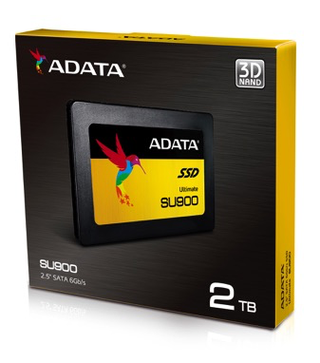Adata's Ultimate SU900 Brings SLC Buffers To 3D MLC SSDs
Adata announced its new Ultimate SU900 SSD, which makes the notable change to Micron's 3D MLC NAND and throws in an SLC buffer for better performance. Adata is the first major third-party SSD vendor with 3D MLC NAND, and also the first to use an SLC buffer on an MLC SSD.
3D NAND has finally trickled down to the third-party manufacturers following a long three-year delay after Samsung initially announced the new technology. Samsung doesn't sell into the third-party market, choosing instead to use its captive supply for its own products. Now that Micron is seeding the smaller players with both TLC and MLC 3D NAND, we can expect more choice on the market, which might break Samsung's current stranglehold.

Many enthusiasts were very skeptical when 2D TLC NAND first came to fruition, and rightly so. TLC NAND offers less endurance and performance than MLC, and though the lower price point is nice, it's hard for us enthusiasts to overlook those limitations. Clever engineers came up with SLC buffers, which use a small portion of the NAND as a fast holding area, to overcome some of the performance penalty. However, the real advance was the move to 3D TLC, and now more SSDs sell with TLC NAND than MLC NAND.
Even though 3D TLC NAND is good enough for most, it still isn't enough to satisfy more demanding users. Adata's SATA 6Gbps SU900 steps up a notch to Micron's 3D MLC NAND paired with the four-channel SMI SM2258 controller and a DRAM buffer. Adata also employs an SLC buffer, which is a first for an MLC SSD. The SLC buffer absorbs incoming write traffic faster than the MLC NAND, which will help boost performance during bursty workloads. The drive comes in the familiar 2.5" form factor with a 7mm Z-height (thickness).
The faster NAND provides up to 85,000/90,000 random read/write IOPS, which is an improvement of 5,000/10,000 read/write IOPS over the TLC-powered SU800. The SU900 moves the needle ever-so-slightly with up to 560/525 MBps of sequential read/write throughput, but we suspect most of the gains will come courtesy of the SLC buffer during lighter workloads.
| Header Cell - Column 0 | Adata SU900 | Adata SU800 |
|---|---|---|
| Capacity | 256GB, 512GB, 1TB, 2TB | 128GB, 256GB, 512GB, 1TB |
| Interface | SATA | SATA |
| NAND | Micron 256Gb 3D MLC NAND | Micron 384Gb 3D TLC NAND |
| Controller | SMI SM2258 | SMI SM2258 |
| DRAM | Yes | Yes |
| Sequential Read/Write (up to) | 560/525 MBps | 560/520 MBps |
| Random Read/Write (up to) | 85,000/90,000 IOPS | 80,000/80,000 IOPS |
| Endurance (up to) | 800TB | 800TB |
| Warranty | 5-Year | 3-Years |
As always, performance varies by capacity, and the SU900 comes in 128GB, 512GB, 1TB, and 2TB options. The 2TB model is a big step up over the previous 1TB limitation, and the company also eliminated the 128GB model. Interestingly, even though the drive comes with the generally more impressive MLC NAND and doubled capacity, it still features the same maximum endurance rating of 800TB. Adata improved the warranty period up to five years, which actually reduces the amount of per-day warrantied data writes compared to the TLC model. The extra warranty period is nice, but we usually expect to see endurance scale with capacity, not to mention the addition of more robust NAND. We've followed up with Adata to clarify.

The Ultimate SU900 also features several staples of modern-day SSDs, such as LDPC error correction, data shaping, and a RAID engine, which provides enough parity for the SSD to recover from failed portions of NAND.
Stay on the Cutting Edge
Join the experts who read Tom's Hardware for the inside track on enthusiast PC tech news — and have for over 25 years. We'll send breaking news and in-depth reviews of CPUs, GPUs, AI, maker hardware and more straight to your inbox.
Adata includes a few goodies, such as a 2.5mm spacer and 3.5" bracket, with the SU900. The 256GB model retails for $113 USD, while the 512GB weighs in at $214.

Paul Alcorn is the Managing Editor: News and Emerging Tech for Tom's Hardware US. He also writes news and reviews on CPUs, storage, and enterprise hardware.
Most Popular

